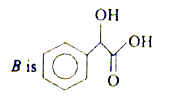Compound (A) on treatment with gives (B) and (C) rearrange to give (D) and (E), respectively, on treatment with acid. (B), (C),(D)and (E) are all isomers of molecular formula . When (D) is boiled with alcoholic KOH, an oil (F) separates out. (F) reacts with to give back (D). On the other hand. (E) on boiling with alkali followed by acidification gives a white solid (G) . Identify (A)to (G).
The following Reaction are
Topper's Solved these Questions
Similar Questions
Compound (A) (C8H8O) on treatment with NH2OH.HCl gives (B) and (C ). (B) and (C ) rearrange to give (D) and E, respectively, on treatment with acid. (B), (C ), (D), and (E ) are all isomers of molecular formula (C8H9NO). When (D) is boiled with alcoholic KOH, an oil (F) (C6H7N) separates out. (F) reacts rapidly with CH3COCl to give back (D). On the other hand, (E ) on boiling with alkali followed by acidification gives a white solid (G) (C7H6O2). Identify (A) to (G).
View SolutionCompound (A) (C8H8O) on treatment with NH2OH.HCl gives (B) and (C ). (B) and (C ) rearrange to give (D) and E, respectively, on treatment with acid. (B), (C ), (D), and (E ) are all isomers of molecular formula (C8H9NO). When (D) is boiled with alcoholic KOH, an oil (F) (C6H7N) separates out. (F) reacts rapidly with CH3COCl to give back (D). On the other hand, (E ) on boiling with alkali followed by acidification gives a white solid (G) (C7H6O2). Identify (A) to (G).
View Solution
Knowledge Check
Compound (A) C8H6O2 on treatment with aq. NaOH followed by acidification gives (B) C3H2O3 which on oxidation gives benzoic acid only:
A B
B C
C D
D
Compound (A) C8H6O2 on treatment with aq. NaOH followed by acidification gives (B) C8H8O3 which on oxidation gives benzoice acid only :
A B
B C
C D
D

Why does not (C) gives (D) or (D1) on treatment with alcoholic KOH or with C2H5Ona+C2H5OH?AE2 reaction requires that two eliminiting groups (H and Br) must be in syn − position.BE2 reaction requires that two eliminating groups (H andBr) must be in anti− position.CE2 reaction requires that base must be bulky.DE2 reaction requires that there should be less steric hindrance around two eliminating groups .
Compound (A) (C8H8O) on treatment with NH2OH.HCl gives (B) and (C ). (B) and (C ) rearrange to give (D) and E, respectively, on treatment with acid. (B), (C ), (D), and (E ) are all isomers of molecular formula (C8H9NO). When (D) is boiled with alcoholic KOH, an oil (F) (C6H7N) separates out. (F) reacts rapidly with CH3COCl to give back (D). On the other hand, (E ) on boiling with alkali followed by acidification gives a white solid (G) (C7H6O2). Identify (A) to (G).
View Solution(a) Compound A (C8H8O)on treatment with NH2OH. HCI gives B and C. B and C rearrange to give D and E, respectively on treatement with acid. B, C, D and E are all isomers of moleculare formula (C8H9N) When D is boiled with alcohol KOH an oil F (C6H7N) separates out F, reacts rapidly with CH3 COOI to give back D. On the other hand. E on boiling with alkali followed by acidification gives a white solid G(C7H6O2). Identify A−G
(b) Carry out the following transformation in not more than three steps. 1-butyne "to" 2-pentanone
View Solution(A) C2H12O (ether) on treatment with PCl5 forms alkyl chlorides (B) and (C ) . (B) and (C ) both on treatment with aq. NaOH give alcohol (D) and (E ), both (D) and (E ) give iodoform test. What are (A),(B),(C ), (D) and (E ) ?
View SolutionA compound (A) C5H9Br on treatment with Mg in dry ether gives a compound (B) which on reaction with acetaldehyde gives an alcohol (C), on mild acidification prolonged treatment of alcohol with equivalent amount of HBr gives a compound (D) which on reaction with alcoholic KOH gives compound (E). compound (E) on ozonolysis followed by treatment with H2∅Zn gives (F). the compound (F) on treatment with base gives 1 acetyl cyclopentene (G). identify (A) to (G).
View SolutionA compound D(C8H10O) upon treatement with alkaline solution of iodine gives a yellow precipitate. The fibtrate on acidification gives a white solid E(C7H6O2). Write the structures of D,E .
View Solution
